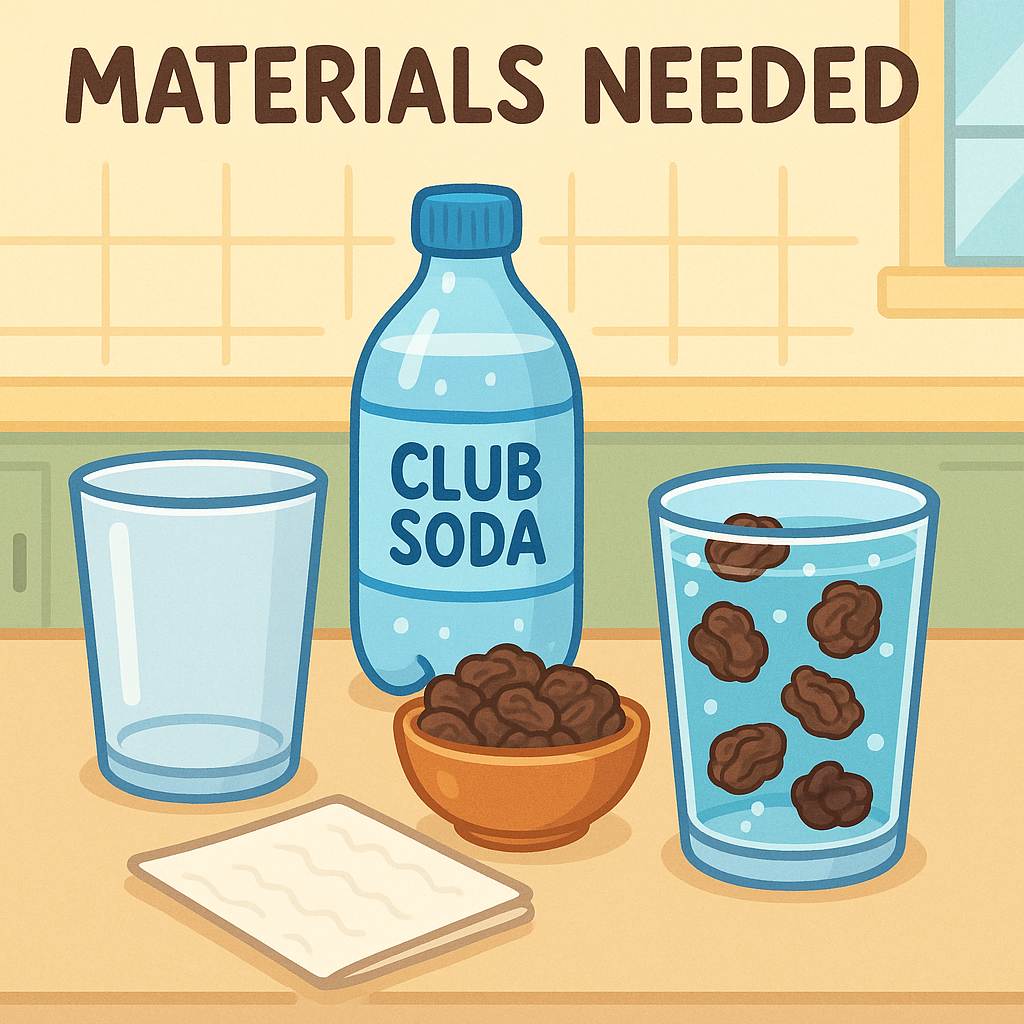 Dancing Raisins:
Dancing Raisins:
Exploring Carbon Dioxide Bubbles in Science
Exploring Carbon Dioxide Bubbles in Science
Have you ever seen raisins dance? This classic, hands-on experiment lets kids discover the power of invisible gases! Using just carbonated water and raisins, students observe how bubbles of carbon dioxide lift and sink objects—making the raisins bounce, rise, and fall in a “dance.” Designed for 3rd–6th grade (but fun for all ages), this activity is safe, quick, and a great introduction to buoyancy, gas behavior, and physical change. Read on for detailed steps, scientific background, and a free printable worksheet.
Experiment Details
- Grade Level: 3rd–6th Grade (adaptable for K–8)
- Key Topics: Carbon Dioxide, Buoyancy, Physical Change
- Estimated Time: 15–20 minutes
- Mess Factor: Low
Purpose: To observe how carbon dioxide gas in carbonated water can lift and sink raisins, demonstrating how gases behave in liquids and the concept of buoyancy.
Hypothesis: If raisins are placed in carbonated water, then bubbles will stick to the raisins and lift them up. When the bubbles burst, the raisins will sink again, repeating the process.
What You’ll Need
- 1 clear glass or plastic cup (about 8 oz)
- 1 cup of clear carbonated water (such as club soda or sparkling water)
- 8–10 raisins
- Paper towel (for clean-up)

Step-by-Step Instructions (with Pictures)
- 1. Pour the carbonated water into your glass.
- 2. Observe the bubbles in the water before adding anything.
- 3. Drop 8–10 raisins into the glass of carbonated water.
- 4. Watch as the raisins sink, then rise and “dance” as bubbles attach and pop.
- 5. When the dancing stops, use a paper towel to clean up.

Results & Scientific Explanation
When you first drop the raisins in, they sink to the bottom because they are heavier than water. But the rough, wrinkled surface of the raisins traps bubbles of carbon dioxide from the soda. When enough bubbles stick, the raisins become lighter and float to the top. At the surface, the bubbles burst, and the raisins sink again. This cycle repeats, making the raisins appear to “dance” up and down in the glass!
- Sinking: Raisins start out heavier than the liquid, so they sink.
- Floating: Bubbles attach and make the raisins less dense, so they rise.
- Repeating: When bubbles pop, the raisins sink and the process repeats.
What Is Buoyancy?
Buoyancy is the upward force a liquid exerts on objects. If an object is less dense than the liquid, it floats. If it’s more dense, it sinks. Here, bubbles decrease the raisins’ density, so they float—until the bubbles burst!
Why Carbon Dioxide?
Carbonated water (like club soda) is filled with dissolved carbon dioxide gas under pressure. When you pour it into a glass, the gas escapes as bubbles—making this experiment work. Try plain water for comparison: the raisins will stay at the bottom.
Learning Objectives
- Understand how gases create movement in liquids
- Learn about buoyancy, density, and floating/sinking
- Observe physical changes (no new substances formed)
- Practice making and testing a hypothesis
Teacher & Parent Tips
- Ask students to describe what they see in their own words.
- Have kids predict what will happen before adding raisins.
- Compare with plain water for a control.
- Discuss real-life buoyancy: boats, balloons, submarines.
- Try different objects (popcorn, pasta) to see what else will “dance.”
Standards Alignment
NGSS 5-PS1-1: Develop a model to describe that matter is made of particles too small to be seen.
NGSS 5-PS1-3: Make observations and measurements to identify materials based on their properties.
Printable Worksheet
Want a ready-to-use printable version for your class or homeschool?

Frequently Asked Questions
Yes! Try popcorn kernels, small pasta shapes, or dried beans. The rougher the surface, the more bubbles will stick.
Plain water has no dissolved gas to form bubbles, so the raisins stay on the bottom.
Make sure you use carbonated water that is still fizzy! Very old soda may not have enough gas left to work. Try with fresh club soda or sparkling water.
This is a physical change—no new substances are created. The carbon dioxide is released as bubbles, but the raisin and water stay the same.
Related Experiments
- Color Changing Cabbage Juice
- Egg Floatation in Different Liquids
- See All Science Experiments & Generator
Share Your Results!
Did you try this experiment? Share your photos, results, or questions below!
⭐ What Parents & Teachers Are Saying
Recent Feedback
There are no reviews yet. Be the first one to write one.
